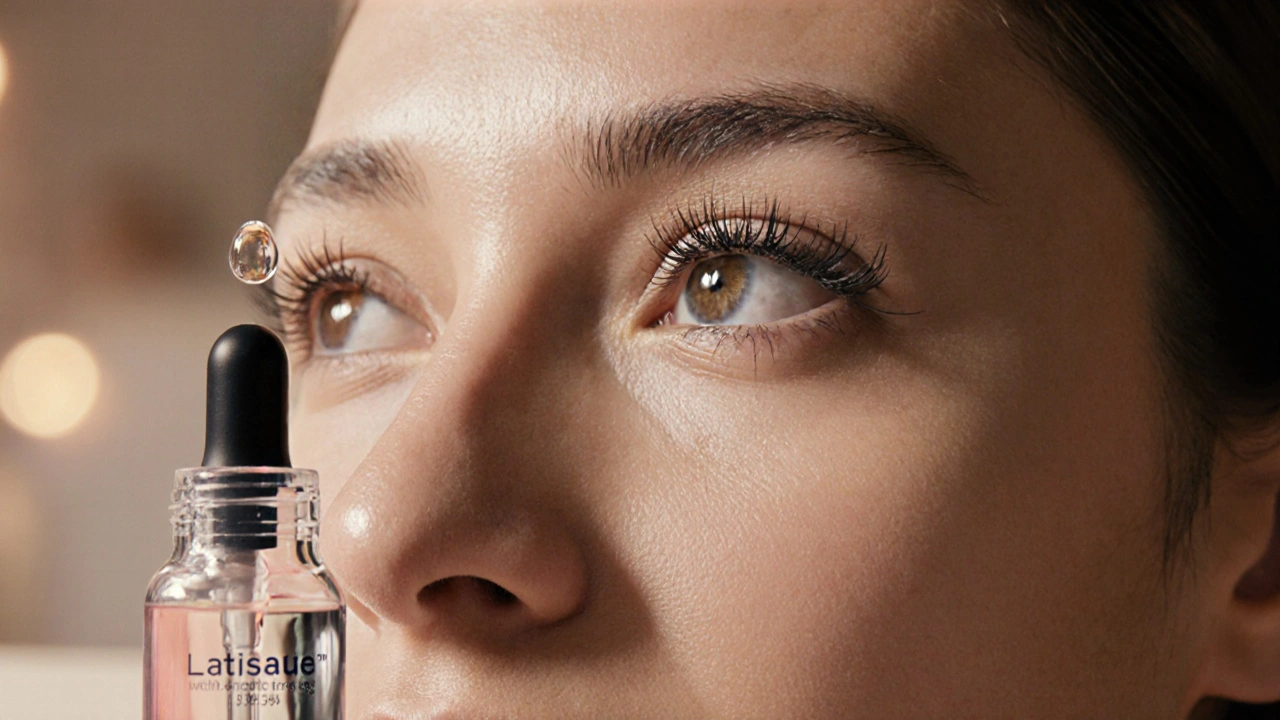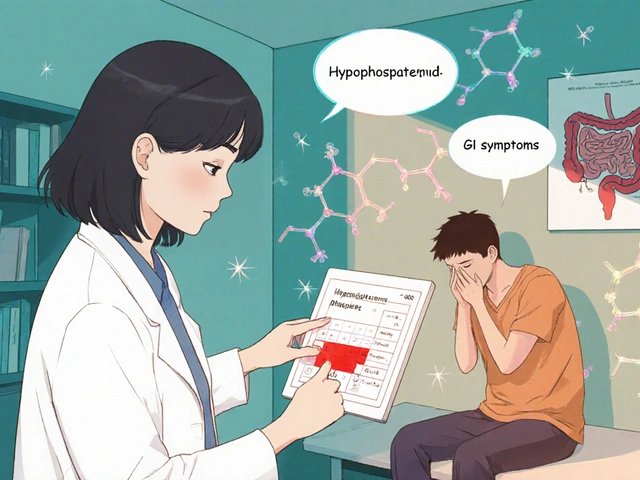Latisse vs. Alternative Eyelash Growth Treatment Comparison
Treatment Comparison Results
Wanted longer, fuller lashes but not sure whether Latisse is the only option? This guide breaks down what Latisse actually does, how it stacks up against other prescription drops and popular DIY tricks, and which choice fits your budget and safety concerns.
Key Takeaways
- Latisse is a FDA‑approved prostaglandin analogue that can grow lashes 20‑30% longer in 12‑16weeks.
- Generic bimatoprost offers similar results for 30‑50% less cost, but may lack the brand’s preservative system.
- Off‑label prostaglandin drops like latanoprost and travoprost work, yet their safety data for eyelash use is limited.
- Natural oils (castor) and biotin supplements provide modest benefits and carry minimal risk, but results are far slower.
- Choose based on prescription access, price tolerance, and how comfortable you are with potential side effects.
What Is Latisse?
Latisse is a 0.03% bimatoprost ophthalmic solution approved by the US FDA for treating hypotrichosis of the eyelashes. The product was launched in 2008 and quickly became the only prescription‑only eyelash growth medication on the market.
How Does Bimatoprost Work?
Bimatoprost belongs to the prostaglandin‑F₂α analogue class. When applied nightly to the lash line, it binds to prostaglandin receptors in the hair follicle, extending the anagen (growth) phase and increasing the number of follicles that produce a full‑length lash. Clinical trials showed average lash length increase of 1.5mm and a 1‑step rise in thickness after 16weeks.

Top Alternatives to Latisse
Beyond the brand name, several alternatives exist. Below are the most commonly considered options, grouped by prescription, off‑label, and over‑the‑counter categories.
Prescription‑Level Alternatives
- Generic bimatoprost - chemically identical drop, typically sold by compounding pharmacies.
- Latanoprost - a prostaglandin analogue approved for glaucoma, used off‑label for lashes.
- Travoprost - another glaucoma drop repurposed in some clinics for eyelash enhancement.
Over‑the‑Counter & Natural Options
- Castor oil - thick vegetable oil rich in ricinoleic acid, widely touted for lash conditioning.
- Biotin supplements - vitaminH that supports keratin production; often marketed for hair and nail health.
Efficacy Comparison
| Product | FDA/EMA Status | Typical Length Gain | Thickness Increase | Common Side Effects |
|---|---|---|---|---|
| Latisse | FDA‑approved (2008) | ≈1.5mm (≈30%) | +1grade (subjective) | Eye redness, darkening of iris, dry eye |
| Generic bimatoprost | Compounded, not FDA‑approved for lashes | ≈1.4mm (≈27%) | +1grade | Similar to brand, occasional preservative irritation |
| Latanoprost (off‑label) | FDA‑approved for glaucoma only | ≈1.2mm (≈20%) | +0.5grade | Darkening of iris, mild irritation |
| Castor oil | OTC, no regulatory approval | ≈0.3‑0.5mm (≈5‑10%) | Minimal | Possible eye‑ringing if not cleaned |
| Biotin (oral) | Dietary supplement | ≈0.2mm (≈3‑5%) | Negligible | Rare, high‑dose gastrointestinal upset |
Safety and Side‑Effect Profile
All prostaglandin‑based drops share a core risk: pigment changes in the iris. While the shift is usually permanent, it typically stays within the same color family (e.g., brown to slightly darker brown). Users with light‑colored eyes should weigh this carefully.
Dry‑eye symptoms are the next most common complaint. A simple artificial‑tear regimen mitigates most irritation. For the non‑prescription options, safety concerns are milder but efficacy is also far lower.

Cost Considerations
In the UK, Latisse costs roughly £85 for a 5‑ml bottle, lasting up to three months when used as directed. Generic bimatoprost from a compounding pharmacy can drop the price to £45‑£55, but you’ll need a prescription and a third‑party pharmacy.
Latanoprost and travoprost are usually stocked for glaucoma patients, costing £30‑£60 per bottle. Using them off‑label adds a layer of legal ambiguity - always discuss with an ophthalmologist first.
Castor oil is the cheapest at under £5 for a 250ml bottle, and biotin supplements range £10‑£20 for a 30‑day supply. The trade‑off is a slow, barely noticeable improvement.
How to Choose the Right Option
- Assess prescription access. If you have a clear diagnosis of eyelash hypotrichosis, a specialist can write a Latisse or generic bimatoprost prescription.
- Budget test. Calculate monthly cost: Latisse (~£28), generic bimatoprost (~£15‑£18), off‑label latanoprost (~£12‑£20).
- Risk tolerance. If iris darkening is a deal‑breaker, stick to natural oils or biotin, accepting modest gains.
- Desired speed. Expect visible changes in 8‑12weeks with any prostaglandin; natural methods may need 6‑12months.
- Consult a professional. An ophthalmologist can screen for contraindications such as active eye infections or hypersensitivity to preservatives.
Practical Tips for Using Latisse Safely
- Apply a single drop to the sterile applicator, then swipe along the base of the upper lashes once per night.
- Avoid contact with the lower eyelid; the solution can cause unwanted hair growth on the skin.
- Never share the applicator - cross‑contamination can spread infections.
- Store the bottle at room temperature, away from direct sunlight.
- If you miss a dose, skip it rather than double‑up; consistency matters more than frequency.
Frequently Asked Questions
Can I use Latisse without a prescription?
No. In the UK, Latisse is a prescription‑only medicine. Using it without a doctor’s oversight risks inappropriate dosing and missing contraindication checks.
Is generic bimatoprost as effective as the brand?
Clinical data shows generic bimatoprost delivers almost identical lash length gains, provided the formulation uses a comparable preservative system. Some users note slightly more irritation, likely from differing excipients.
Will my eye color change permanently?
Prostaglandin drops can darken the iris. The change is usually permanent but modest, staying within the same hue family. Light‑eyed patients should discuss this risk before starting.
How long does it take to see results?
Most users notice subtle improvement after 4‑6weeks, with full results emerging around 12‑16weeks. Stopping the treatment will cause lashes to revert to their baseline within a few months.
Are there any safe over‑the‑counter alternatives?
Castor oil and biotin are the most popular OTC options. They are safe for most users but produce very modest growth - think 5‑10% longer lashes after several months.
Whether you go with the clinically proven Latisse, its cheaper generic twin, an off‑label glaucoma drop, or a natural oil, the right choice hinges on how quickly you want results, how much you’re willing to spend, and how comfortable you are with possible side effects. Armed with this comparison, you can talk to your eye‑care professional and pick the route that matches your goals.








Posts Comments
TRICIA TUCKER October 6, 2025 AT 13:50
Hey folks, great deep‑dive! It’s awesome seeing a clear side‑by‑side of Latisse and the budget‑friendlier options. Whether you’re after dramatic length or just a tiny boost, there’s something for everyone here. Plus, the safety notes are super helpful for anyone new to prostaglandin drops.
Dave Tu October 9, 2025 AT 01:50
While the table is tidy, it neglects to emphasize the paucity of robust peer‑reviewed data on off‑label prostaglandin use for lashes. The author glosses over potential long‑term iris pigmentation changes, which remain insufficiently quantified in the literature. Consequently, the presented cost‑benefit analysis is, at best, superficial.
Johnna Sutton October 11, 2025 AT 13:50
It is with a solemn sense of duty that I point out the hidden agenda behind mainstream ophthalmic endorsements. The pharma giant behind Latisse subtly steers us away from affordable compounding alternatives, ensuring a perpetual profit stream. Misspelling aside, one must ask: who truly benefits from the oft‑cited “FDA‑approved” badge?
Vinay Keragodi October 14, 2025 AT 01:50
Interesting that the compounding pharmacies can hook you up with generic bimatoprost at half the price. I wonder how consistent the preservative quality is across different labs? Some users report tiny irritation, others say it works like a charm. It’d be cool to hear real‑world experiences.
Cassidy Strong October 16, 2025 AT 13:50
As a point of precision, the author failed to note that the “≈1.5 mm” figure for Latisse is an average; individual variance can be ±0.4 mm! Moreover, the claim that “dry‑eye symptoms are the next most common complaint” lacks citation. Such omissions diminish the article’s credibility.
Anil Karwal October 19, 2025 AT 01:50
Just a heads‑up: if you decide to try castor oil, make sure the bottle is clean. A little residue can cause that annoying ringing feeling around the eye. It’s cheap, but patience is key; you won’t see dramatic changes overnight.
Suresh Pothuri October 21, 2025 AT 13:50
Let me be crystal clear: the only scientifically validated route to longer lashes is a prostaglandin analogue, preferably the patented version. Generic formulations can match efficacy only if they adhere to strict sterility protocols, which many Indian compounding labs overlook. Choose wisely.
Millsaps Mcquiston October 24, 2025 AT 01:50
Got it. Latisse costs more but works fast. Generic is cheaper and similar. Natural oils are cheap but slow.
michael klinger October 26, 2025 AT 13:50
One cannot ignore the shadowy implications of allowing a single corporation to dominate the eyelash enhancement market. The subtle coercion of prescribing practices, combined with undisclosed funding of certain studies, creates an environment ripe for manipulation. Vigilance is essential.
Matt Laferty October 29, 2025 AT 01:50
Choosing the right eyelash growth strategy really boils down to three core considerations: efficacy, safety, and sustainability. First, efficacy – Latisse and its generic counterpart consistently deliver a 20‑30% increase in lash length within a three‑month window, a benchmark that natural oils simply cannot match. Second, safety – while prostaglandin drops do carry the risk of iris darkening, this side effect is predictable and generally mild; patients with lighter irises should be counselled accordingly, and routine artificial tear use can mitigate dryness. Third, sustainability – the ongoing cost of a prescription can add up, especially if you’re on a tight budget; in such cases, a compounded generic at roughly half the price of brand‑name Latisse can provide comparable results without sacrificing quality, provided the compound is sourced from a reputable pharmacy that follows Good Manufacturing Practices. Additionally, patients should factor in the convenience of application; a single nightly drop is far less time‑consuming than the ritualistic brushing of castor oil multiple times a day. That said, for those who prioritize a fully natural regimen, castor oil offers a low‑risk, low‑reward alternative – expect only modest improvements after several months, and keep the eyelid clean to avoid irritation. Biotin supplements, meanwhile, might support overall hair health but lack direct evidence for lash elongation; they could be used adjunctively if you’re already taking a multivitamin. In summary, if rapid, measurable results are your priority and you can manage a modest prescription expense, Latisse or its generic is the clear winner. If cost is a major barrier, the generic bimatoprost presents a compelling compromise. For the ultra‑cautious or budget‑constrained, castor oil remains a safe but slow path. Always discuss with an ophthalmologist to rule out contraindications such as active ocular infection before starting any regimen.
Genie Herron October 31, 2025 AT 13:50
Wow this is so helpful.
Danielle Spence November 3, 2025 AT 01:50
It’s ethically troubling that many people chase the perfect lash at the expense of their ocular health. The allure of a longer look should never eclipse the responsibility we have to protect our bodies. We should demand transparent data from manufacturers and insist on informed consent that truly outlines the permanence of iris color changes. The beauty industry’s push for quick fixes often downplays these serious considerations, and that is unacceptable.
Dhanu Sharma November 5, 2025 AT 13:50
All in all, good summary and useful tips for anyone thinking about trying any of these options.
Write a comment